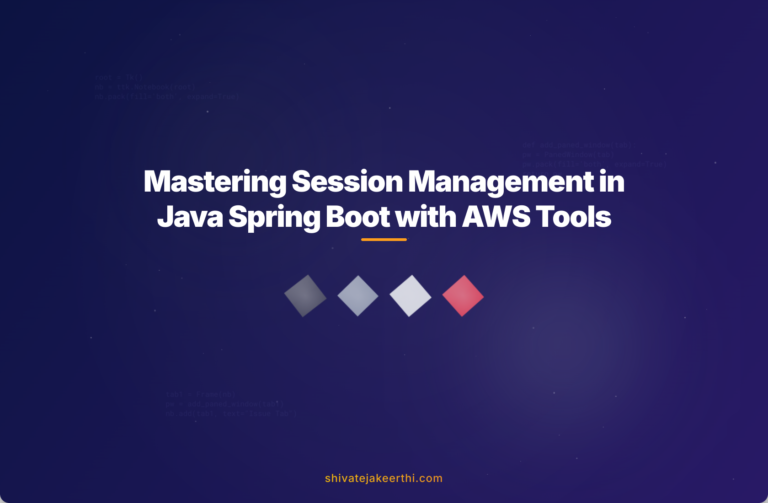Java Spring Boot has become a go-to framework for developing robust and scalable microservices. On AWS, Spring Boot applications combine ease of deployment with powerful cloud capabilities. However, effectively handling session attributes can get tricky in distributed, cloud-based microservices. Let’s break down practical steps to manage session attributes correctly and safely using AWS services and Spring Boot.
Getting Started: Deploying Java Spring Boot Applications on AWS
If you haven’t deployed your Spring Boot microservices onto AWS yet, here’s your quick checklist:
- Create your AWS account: Sign up at the official AWS website.
- Set up an EC2 instance: Amazon Elastic Compute Cloud (EC2) provides scalable computing capacity. Launch an instance from your AWS Management Console, choosing the appropriate AMI (Amazon Machine Image) for your application.
- Deploy your Spring Boot Microservice: Export your Spring Boot app as a JAR file. Using SCP or SFTP (like FileZilla), upload your JAR file to EC2. Launch it from the command line using:
java -jar yourApp.jar
Now your application is running in a reliable environment, ready to handle users and sessions.
Session Attributes in Java Spring Boot: What’s the Big Deal?
Session management makes user interactions meaningful. It keeps track of user-specific data across requests—imagine an online store remembering items you added to your cart or a web application securely maintaining your login status.
Java Spring Boot handles sessions through the HttpSession interface, allowing developers to store, retrieve, and manage attributes easily:
@GetMapping("/setSession")
public String setSession(HttpSession session) {
session.setAttribute("username", "JohnDoe");
return "Session attribute 'username' set!";
}
@GetMapping("/getSession")
public String getSession(HttpSession session) {
String username = (String) session.getAttribute("username");
return "Hello, " + username;
}
Types of Session Management
- In-memory sessions: Session data lives directly within the application’s JVM memory. This method is simple but doesn’t scale horizontally.
- Distributed sessions: Session data is externalized to technologies like Redis, AWS ElastiCache, or databases. Ideal for cloud microservices requiring horizontal scaling.
Configuring Session Attributes in Java Spring Boot for AWS
To manage sessions effectively on AWS, you’ll first want to set essential properties in application.properties or application.yml:
# application.properties
server.servlet.session.timeout=30m
server.servlet.session.cookie.http-only=true
server.servlet.session.cookie.secure=true
Leveraging AWS ElastiCache for Sessions
In AWS environments, especially with horizontally scaled applications, sessions should be externalized. AWS ElastiCache (with Redis or Memcached) provides excellent high-performance storage for session attributes.
Here’s what integrating Spring Boot sessions with Redis on ElastiCache typically looks like:
- Provision an AWS ElastiCache Redis instance via your AWS Management Console.
- Add dependencies for Redis and Spring-session in your project’s pom.xml:
<dependency> <groupId>org.springframework.boot</groupId> <artifactId>spring-boot-starter-data-redis</artifactId> </dependency> <dependency> <groupId>org.springframework.session</groupId> <artifactId>spring-session-data-redis</artifactId> </dependency> - Configure Redis in your application.properties:
spring.redis.host=your-elasticache-endpoint spring.redis.port=6379 spring.session.store-type=redis
With these steps, your microservices will seamlessly handle session data across multiple instances, remaining performant and resilient.
Best Practices for Session Management in Microservices
Effectively managing session attributes is more than just storing and retrieving. Consider these best practices for your microservices deployed on AWS:
- Secure session storage: Always store sensitive data like tokens and user credentials securely. Use server-side storage with ElastiCache Redis or an encrypted database.
- Scalability: Keep session sizes small to maintain fast retrieval and reduce network latency. The smaller each payload, the better.
- Monitoring & Logging: AWS CloudWatch is great for real-time monitoring and logs. Configure AWS CloudWatch metrics and logs for session management alerts and troubleshooting purposes.
Adding Fault Tolerance with Spring Cloud
In distributed microservices, faults can happen. Spring Cloud tools like Hystrix or Circuit Breaker help manage session attribute retrieval faults gracefully. This ensures that if your Redis connection or storage fails, your microservices won’t completely break down.
A simple Circuit Breaker setup prevents cascading failures by falling back safely when sessions become unreachable:
@HystrixCommand(fallbackMethod = "sessionFallback")
public String getSession(HttpSession session) {
String username = (String) session.getAttribute("username");
if(username == null) throw new RuntimeException("Session data unavailable");
return username;
}
public String sessionFallback(HttpSession session) {
return "Guest";
}
Keeping Session Attributes Secure on AWS
Security of session data can’t be an afterthought. Protecting sessions against tampering, hijacking, or leakage is critical. Here’s how:
- Encrypt Session Data: Utilize AWS Key Management Service (KMS) to encrypt sensitive attributes stored in Redis or database.
- HTTP-Only Cookies: Enable HTTP-only flags on session cookies so malicious scripts cannot access them.
- Secure Session Cookies: Always use HTTPS connection for secure cookie transmission to prevent session hijacking.
Monitoring and Troubleshooting Sessions with AWS CloudWatch
AWS CloudWatch paired with AWS X-Ray can monitor performance bottlenecks, failures, and unusual activity. Set up CloudWatch logs for your sessions by configuring CloudWatch Logs agent or integration within your EC2 instance:
- Create CloudWatch Log Group on AWS console.
- Install CloudWatch Logs agent on EC2 instance.
- Configure logs path (e.g., Spring Boot app’s log files).
CloudWatch logs will help troubleshoot issues rapidly, spotting unusual patterns and errors fast.
Common Issues & Troubleshooting Tips:
- Sessions not persisting across load balancer: Check sticky session settings, or better yet, switch to distributed sessions with Redis.
- Session expiration too quickly or lingering too long: Adjust timeout settings within your Spring Boot properties or custom logic.
- Slow session retrieval: Scale up your ElastiCache Redis instance or reduce your session attribute sizes.
Handling session attributes effectively on AWS with Java Spring Boot doesn’t have to be complicated. It requires thoughtful configuration, practical security measures, and leveraging the right AWS services.
By following the guidelines and best practices highlighted here, you can create performant, robust, secure microservices that handle sessions gracefully, scale effortlessly, and remain reliable even under challenging conditions.
What steps will you take next in improving the session handling in your Java Spring Boot microservices on AWS? Share your thoughts or challenges in the comments below!



0 Comments